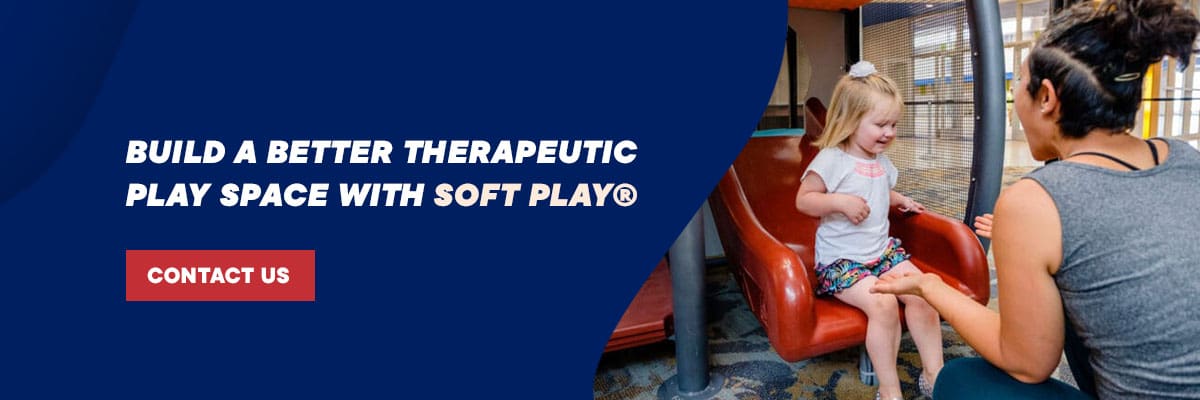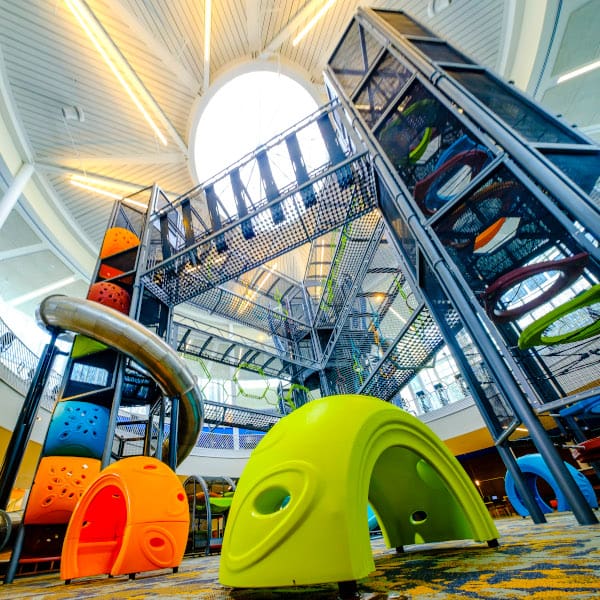The Benefits of Play in Occupational Therapy for Children
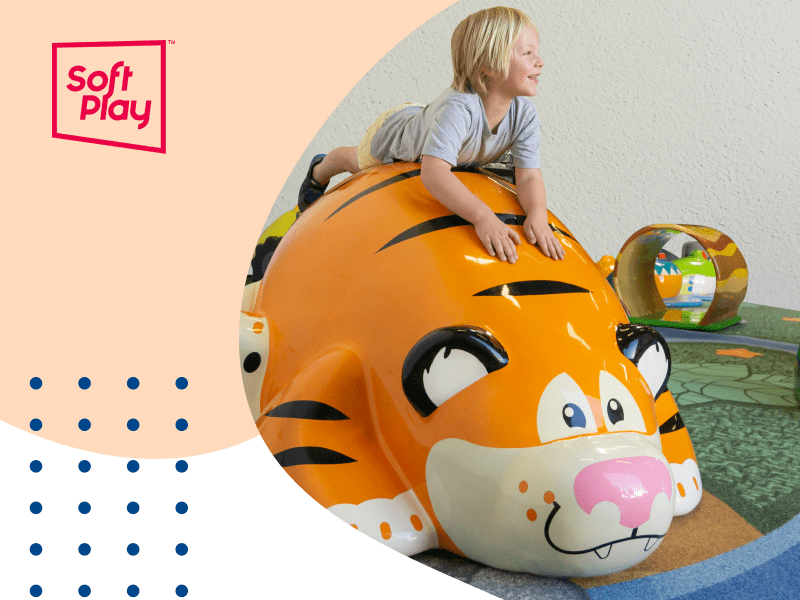
The Benefits of Play in Occupational Therapy for Children
From birth, babies’ brains start to form billions of connections and pathways between the neurons, shaping critical brain architecture before age 5. Play is a vital activity that shapes how kids learn, grow and connect with the world.
In occupational therapy, play can turn therapy sessions from challenging work into exciting, motivating experiences. By tapping into the natural joy and curiosity of play, therapists can help kids achieve meaningful progress in ways that feel fun and rewarding.
Explore the powerful role of play in occupational therapy and how the right environment can make all the difference.
What Is Play-Based Occupational Therapy?
Play-based occupational therapy uses a kid’s natural drive to play as the foundation for building essential life skills. Unlike unstructured “free play,” play-based OT is intentional and goal-oriented, with therapists carefully selecting activities that target developmental needs. It recognizes that kids learn best when they’re having fun.
Here’s more about this approach:
- It uses structured, purposeful activities to achieve developmental goals.
- Therapists design play scenarios to improve skills like coordination, attention and social interaction.
- The approach caters to each child’s interests and abilities, promoting engagement and motivation.
- Play-based OT differs from free play by focusing on outcomes and progress, not just entertainment.
How Play Facilitates the Benefits of Occupational Therapy
Play fully engages kids’ bodies and minds. It allows them to explore, experiment and practice new skills in a safe, motivating and meaningful way that mirrors real-life challenges and social interactions. In occupational therapy, play is carefully structured to help kids develop in different areas simultaneously.
Here is a breakdown of the specific ways play supports growth and progress.
1. Improving Motor Skills and Coordination
The role of play in pediatric occupational therapy is centered on giving kids opportunities to practice and refine their movement skills naturally. A kid needs a strong, stable core and shoulder and arm muscles to perform fine motor tasks. Without this foundational strength and control, kids may struggle with hand skills and compensate in ways that affect their play and daily activities.
Occupational therapists use targeted play activities to help kids strengthen their bodies and improve coordination in a way that feels like fun, not work. These activities may include:
- Climbing, balancing and crawling to build core strength and body awareness.
- Manipulating small objects, stacking blocks or threading beads to improve fine motor skills and hand-eye coordination.
- Practicing repetitive, playful movements to develop muscle memory and confidence in their physical abilities.
2. Supporting Sensory Integration and Processing
A sensory-rich play environment allows kids to explore and process different types of sensory input. This is especially important for neurodiverse kids with sensory processing challenges, who may struggle to interpret or respond to everyday sensations. For example, play-based therapy has been shown to improve playfulness and social play in learners with autism.
Approaches and benefits include:
- Activities like swinging, spinning or sliding: These movements allow the gathering of sensory information from the inner ear — about the position of the head and movement in relation to gravity — helping kids understand movement and balance.
- Exploring different textures: Is it soft, rough or squishy? Using play panels, ball pits or textured surfaces can support tactile processing.
- Visual and auditory input: These elements in play spaces help kids adapt to new sights and sounds in a controlled way.
3. Encouraging Cognitive and Social Growth
While a kid’s job is to play, interact and learn, it is also to be a sibling and classmate. Play is a natural context for kids to develop thinking skills and learn how to interact with others. Occupational therapists use play to nurture cognitive and social-emotional growth through problem-solving games and imaginative play that activate planning, sequencing and flexible thinking.
Group activities teach turn-taking, sharing, eye contact and communication skills, while play scenarios help kids practice emotional regulation, empathy and resilience in a supportive setting.
The Role of Play in Occupational Therapy
Occupational therapists are experts at analyzing and adapting activities to meet each kid’s needs. In pediatric OT, play is a carefully crafted experience designed to provide a “just-right challenge” that builds confidence and motivation for targeted results.
1. Identifying Individual Needs and Setting Goals
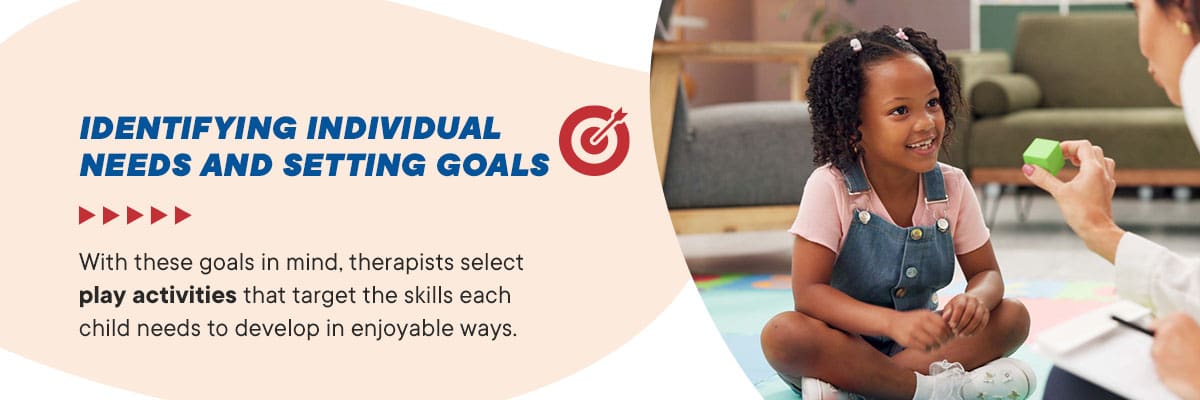
2. Adapting Activities for Success and Engagement
During occupational therapy play, activities are continually adapted in real time to match abilities and responses. If a task is too easy, the therapist may introduce a new element to increase the challenge. If too hard, they can modify the activity to ensure the child experiences success. This dynamic approach keeps kids engaged and motivated, turning potential frustration into opportunities for achievement.
3. Emphasizing the Unique Value of Occupational Therapy Expertise
The occupational therapist’s expertise is what makes play fun and therapeutically effective. A blend of clinical knowledge and creativity allows therapists to turn play into a powerful tool for growth. For parents and caregivers, this validates the therapist’s role as a skilled professional guiding their child toward meaningful progress.
How Parents Can Support a Play-Based Approach
The involvement of parents and caregivers in play-based occupational therapy is important for building strong parent-therapist relationships based on trust and communication. By understanding the goals behind play activities and reinforcing them at home, families can help kids make even bigger strides.
Below are some ways parents and caregivers can play an active role in their child’s OT.
1. Communicate and Collaborate With Your Child’s Therapist
Don’t hesitate to ask questions about the purpose of specific play activities or the skills they are designed to develop. Understanding the “why” behind play-based OT helps you reinforce those same skills at home and ensures consistency between therapy sessions and daily routines. Regular check-ins with your therapist can also help you track your child’s progress, celebrate milestones and adjust strategies as needed.
2. Reinforce Skills at Home With Everyday Activities
You don’t need specialized equipment to support your child’s development at home. Many everyday tasks can be turned into therapeutic opportunities. For example, carrying groceries or laundry baskets provides “heavy work” that builds strength and body awareness. Cooking together can improve fine motor skills through stirring, pouring and using utensils.
Unstructured leisure time, such as climbing at the playground, riding a bike or playing hopscotch, helps develop balance, coordination and confidence. Even simple games like building with blocks, drawing or playing catch can reinforce the skills your child is working on in therapy.
3. Create a Supportive and Engaging Home Environment
Observe the therapy environment and consider how you can replicate some of its features at home. While you may not be able to install a full play structure, you can invest in a few high-quality, versatile pieces of equipment — like a small indoor swing, a balance beam or textured mats — that encourage movement and sensory exploration.
Rotating toys and play materials keeps your child engaged and motivated. Designate a safe, clutter-free space for active play, and encourage your child to explore and try new activities.
4. Advocate for Your Child’s Needs
As a parent or caregiver, you are your child’s best advocate. If you notice that your child’s therapy environment lacks certain resources or equipment, don’t hesitate to speak up. Share your observations and concerns with your therapist or facility manager and ask about options for enhancing the play space. You can also connect with other parents to share ideas and resources or seek out community programs that offer inclusive play opportunities.
5. Enhance Social and Emotional Growth Through Play
Play is a powerful way to support your child’s social and emotional development. Arrange playdates or small-group activities where your child can practice sharing, turn-taking and communication in a relaxed setting. Use pretend play to explore emotions, problem-solving and empathy. Celebrate your child’s efforts and progress, no matter how small, to build their confidence and resilience.
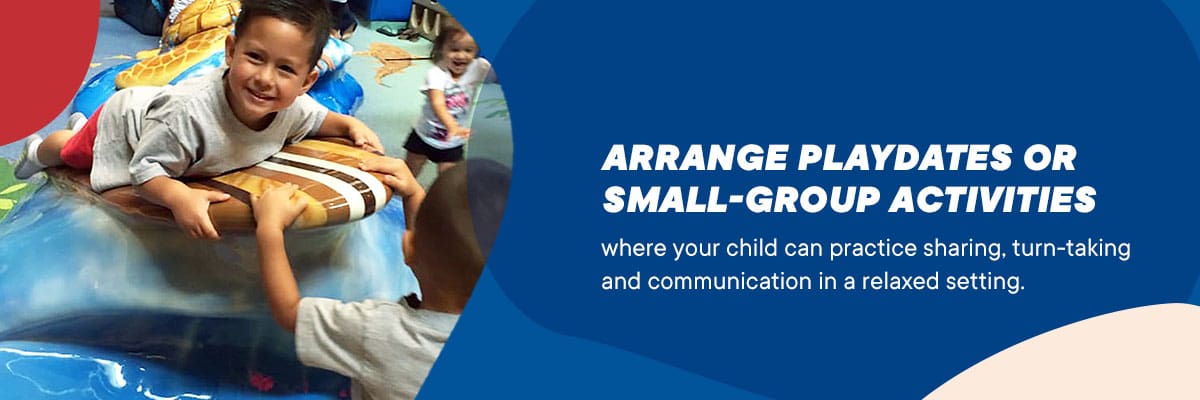
6. Stay Informed and Empowered
Finally, take advantage of educational resources, workshops and support groups for families of kids in occupational therapy. The more you learn about play-based OT approaches and child development, the better equipped you’ll be to support your child’s journey. Remember, your involvement makes a real difference — in therapy and in every aspect of your child’s growth and well-being.
By actively participating in your child’s play-based occupational therapy, you help create a strong foundation for lifelong learning, independence and joy.
How to Create the Ideal Therapeutic Play Environment for Meaningful Progress
The physical environment is the foundation of successful play-based occupational therapy. A well-designed, purpose-built space makes therapy engaging and effective, and ensures safety and adaptability for every kid’s unique needs. Optimal play environments with sensory-rich, durable, easy-to-clean equipment empower therapists to deliver a wide range of developmental activities.
Below are some real-world examples of how the right environment — paired with the right expertise — turns play into powerful therapy.
1. Activities for Gross and Fine Motor Skills
Gross and fine motor skills are the foundation for many daily activities, from running and jumping to writing and buttoning a shirt. Modular equipment and soft-sculpted structures are designed to strengthen these skills in fun, motivating ways:
- Navigating a soft-sculpted interactive challenge course to improve balance, coordination and core strength
- Climbing walls with varied grips to build hand, arm and upper body strength
- Crawling through tunnels or over foam ramps to develop core stability and bilateral coordination
- Jumping between stepping stones or onto mats to practice controlled movement and spatial awareness
- Throwing, catching or rolling soft balls to improve hand-eye coordination and reaction time
- Connecting modular foam pieces, stacking blocks or threading beads to refine fine motor control
- Manipulating zippers, buckles, mazes or an abacus on engaging play panels to build finger strength and dexterity
- Using tweezers or tongs to pick up small objects for improved pincer grasp and precision
- Transitioning safely from one level to another on play equipment using fine and gross motor skills
2. Activities for Sensory and Emotional Regulation
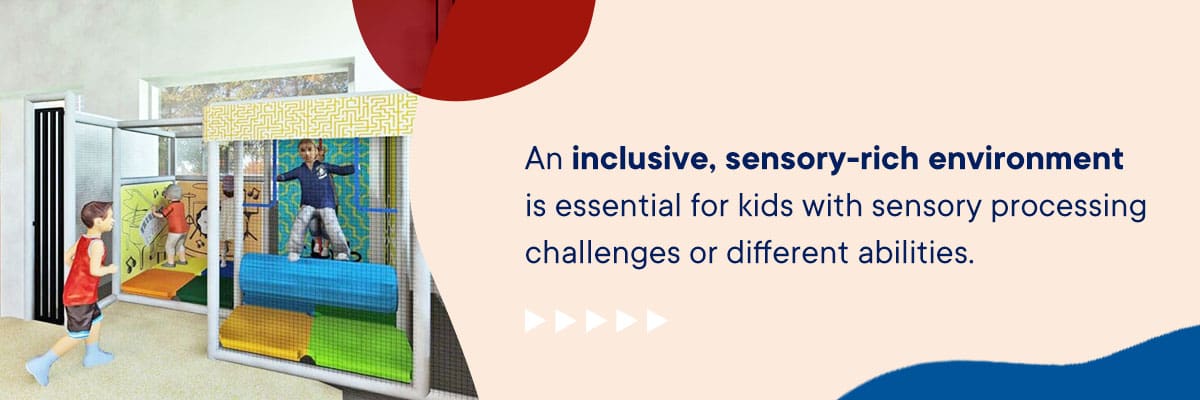
- Using a ball pit to provide deep pressure input, which can be calming and organizing
- Swinging in a controlled arc or on a platform swing to help with vestibular processing, balance and calming
- Using “crash pads” or soft landing zones that offer kids a safe way to jump, fall or roll, helping them release energy and learn self-regulation
- Exploring textured mats, sensory walls or bins filled with materials like sand, rice or water beads to stimulate tactile processing
- Playing with light-up toys or following moving lights to engage visual tracking and attention
- Listening to calming music or rhythmic sounds to support auditory processing and relaxation
- Using weighted blankets or vests during play for additional proprioceptive input and calming effects
- Engaging in “heavy work” activities, such as pushing weighted carts or carrying soft blocks, to help organize the nervous system
3. Activities for Cognitive and Social Growth
Play is a natural context for developing thinking skills and learning how to interact with others. Customizable environments support a variety of imaginative and interactive activities that encourage development and social-emotional learning:
- Building forts or imaginative structures with large foam blocks to encourage planning, sequencing and problem-solving
- Playing turn-taking games, like rolling a ball back and forth or passing objects in a circle, to teach patience and cooperation
- Engaging in pretend play scenarios to build language, creativity and flexible thinking
- Participating in group obstacle courses or using interactive play equipment to practice teamwork and communication
- Using board games or matching games to develop memory, attention and following directions
- Acting out stories or role-playing with puppets to enhance emotional expression and empathy
- Playing “Simon says” or other movement games to improve listening skills and impulse control
- Solving puzzles or completing scavenger hunts to boost cognitive flexibility and perseverance
By combining a thoughtfully designed environment with versatile, high-quality equipment, therapists can tap into the importance of play for children in OT to support every aspect of their development. These spaces make therapy more effective and enjoyable, helping kids build the skills they need for everyday life, one playful moment at a time.
Build a Better Therapeutic Play Space With Soft Play®
Soft Play is a leader in creating commercial-grade, contained play solutions that are ideal for therapeutic settings. Our equipment is designed to be engaging and customizable, helping therapists create the ideal environment for occupational therapy play that aids kids’ growth and development.
Our solutions enable clinics and facilities to tailor play spaces to their unique needs. For example, the ATOM is a fully enclosed play area. The structure features a slide, hammock, scoop-shaped decks and features like the sit-n-spin, musical panel and three-in-a-row game. It’s perfect for smaller spaces, but it has many of the elements needed to develop motor skills and cognitive and social growth.
Ready to enhance your therapy environment? Contact us today to learn how you can design a play space that maximizes the benefits of occupational therapy for every child. Investing in high-quality play equipment is an investment in better outcomes for kids in occupational therapy.
